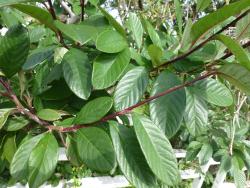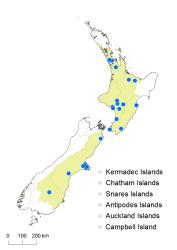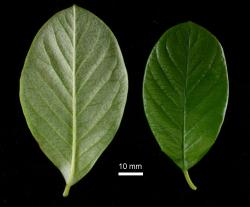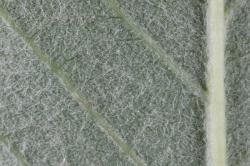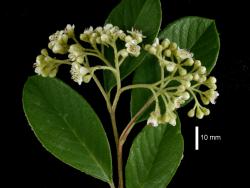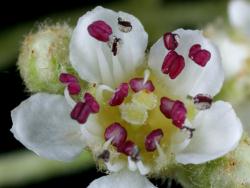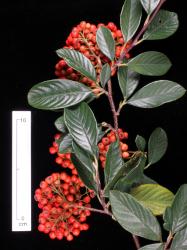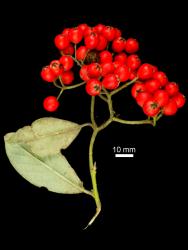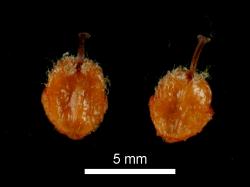- = Cotoneaster lacteus W.W.Sm., Notes Roy. Bot. Gard. Edinburgh 10: 23 (1917)
Erect shrub to small tree 2–5(6) m tall, evergreen; branches arching, branchlets reddish-brown to grey-brown, lenticels present, branchlets with dense yellow tomentum when young, ageing to white later in season. Stipules 3.3–6.5 mm long, green or red. Leaves crowded on branches, 65–105 mm long, lamina 52–92 mm long, 31–50 mm wide, elliptical to obovate, plane to distinctly V-shaped, thick (240–350 µm), petiole 3–12 mm long with hairs dense, white, or yellow; lamina base cuneate; apex obtuse to rounded, apiculus straight; lateral veins 6–9 pairs, midvein and lateral veins impressed on upper leaf surface and projecting on lower surface, upper surface slightly rugose, moderate olive green to dark green (RHS 136A–137A), semi-glossy, hairs sparse when young, old leaves glabrous above; margins slightly recurved; lower surface glaucous, young leaves densely white tomentose, tomentum sparse and white on old leaves.
Inflorescence a compound corymb of 50–92 flowers 40–105 mm long, rachis dense with pale yellow tomentum becoming white later in season. Pedicels 2–6 mm long with dense, pale yellow hairs becoming white with age. Flower 7.2–8.5 mm diameter. Hypanthium green, red at sepal tips, densely lanate with pale yellow hairs, sepals 1.0–1.5 mm long, 1.5–2.2 mm wide. Petals in bud white, occasionally pink, spreading and white when open, 2.7–3.0 mm long, 2.8–3.1 mm wide, slightly clawed, hair tuft present or absent, margins entire or toothed. Stamens (19)20, filaments 2.8–3.0 mm long, white, anthers 0.80–0.85 mm long, red-purple. Styles 2(3), 2.3–2.5 mm long. Fruit vivid red (RHS 44A), slightly obovoid, 6.0–9.0 mm long, 6.2–8.4 mm diameter, calyx closed, glabrous or hairs confined to calyx and pedicel. Pyrenes invariably 2, 3.6–4.3 mm long, 2.9–3.2 mm wide, hairs moderately dense, umbonate, style attached 0.4–0.8 mm below pyrene apex.
Cotoneaster lacteus is treated as a synonym of C. coriaceus by Lu & Brach (2003) and Dickoré & Kasperek (2010), but Fryer & Hylmö (2009) recognise both species. Fryer et al. (2014, p. 455) say "Cotoneaster lacteus sometimes is synonymised with C. coriaceus Franchet (for example, L. Lingdi and A. R. Brach 2003). As treated here, plants of this species are ... with adaxial surfaces bulging between lateral veins.... Plants of C. coriaceus ... with flat adaxial surfaces ...". Lu & Brach (2003) and Dickoré & Kasperek (2010) are followed here. If two species are accepted, New Zealand material belongs to C. lacteus as the leaves are slightly rugose. A mature tree in the grounds of Auckland University (incorrectly labelled on the tree C. harrovianus, CHR 637375) has non-rugose leaves and would then represent C. coriaceus.
An evergreen shrub with arching branches; leaves 20–45 mm long, elliptic, lateral veins impressed, in 7–10 pairs, young leaves distinctly yellow-tomentose below, old leaves slightly glaucous below; corymbs of many (50–104) flowers, petals white and spreading, stamens c. 20, fruit red. Styles/pyrenes 2(3), style inserted 0.4–0.8 mm below pyrene apex.
Most similar to Cotoneaster glaucophyllus. Both are moderately large shrubs with arching branches, both have medium-sized leaves that are elliptical to obovate and have few or no hairs on the upper surface and dense tomentum on the lower surface of new leaves, which disappears so that old leaves are glabrous or sparsely hairy on the lower surface. Both have compound corymbs of flowers that have white spreading petals that lack a hair tuft. Stamens in both species are 20, filaments white and anthers purple. Styles are 2 per flower in both. Fruit in both species are relatively small (4–6 mm long), vivid reddish-orange, and always with 2 pyrenes with the style attached only slightly below the pyrene apex. Both mature their fruit in autumn (late March to April) and so are the two last Cotoneaster species to mature their fruit.
Cotoneaster coriaceus has larger leaves (lamina 64–92 mm × 31–50 mm rather than 58–69 mm × 24–33 mm in C. glaucophyllus), the margins are recurved (not plane), the lateral veins more impressed on the upper surface and more prominent on the lower surface, the leaves are a darker green when old (usually mid yellow-green to mid green in C. glaucophyllus), and they are slightly obovate rather than elliptic. Flowers are more numerous per inflorescence (50–104, rather than 16–60). Fruit are larger (6.2–8.4 mm in diameter, rather than 4.5–6.4 mm in diameter). Cotoneaster coriaceus is much less common in the wild than C. glaucophyllus.
By 1988 a number of wild plants had been collected in urban situations in Christchurch and one in Wellington City.
Auckland (Auckland City, 1987–2015), Volcanic Plateau (Ngongotahā, 1994; Mt Tarawera, 1980; Raetihi, 2015; Taihape), Southern North Island (Kai-iwi, 2002; Parapara Road, 1990; Masterton, 2004; Whanganui, 2006; Hunterville, 1995; Te Mata Peak Road, 2002; Levin, 1989; Wellington City, 1999), Marlborough (Waimā R, 2015), Canterbury (Christchurch City, 2000; Prices Valley, 2007; Port Levy, 2014), Otago (Alexandra, 1993). Common in cultivation throughout New Zealand.
CHR 436402, D.R. Given 14252, 15 Mar. 1986, Christchurch, Jeffreys Road.
Flowering: late November to early December; Fruiting: March to July
Tetraploid (Fryer & Hylmö 2009, p. 48), confirmed by flow cytometry using CHR 638100.



